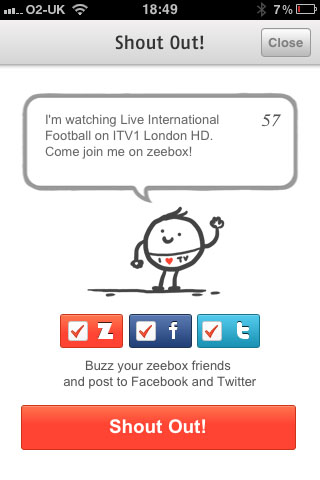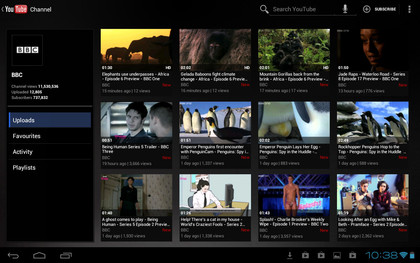How our second screen habit is changing TV forever
Phones and tablets bringing rapid change
Social & interactive TV apps
One relatively recent innovation is the social or companion app. There are several available, with Zeebox – which is partly owned by Sky, ComCast and NBCUniversal – one of the most well-known, though there are others, like the US-centric GetGlue. Zeebox is basically a platform to chat about live TV shows and follow celebrities' TV-watching habits, though it's most skilful at showing where 'the buzz' is. It was invaluable during the Olympics when it was often difficult to keep-up with where and when a plucky Brit might make a play for a medal. Zeebox on a smartphone or tablet also remotely controls a Sky or Virgin TiVo box as well as smart TVs from Sony, Samsung, Panasonic and LG, and fully integrates with Twitter.

The second screen thus far is a place to surf the web or YouTube, watch catch-up TV, or join-in a Twitter debate about a live TV show, but getting apps in-sync with a live TV broadcast is where interactive apps could really come alive.
UK tech start-up Capablue has worked with Channel 4 and others on ways to develop engaging yet properly targeted, unobtrusive second screen advertising, including for Fonejacker and Made In Chelsea. So far they've been largely proof of concept apps, but the technology is intriguing and already polished; Capablue's Connected platform uses audio watermarking to synchronise with a linear broadcast. The mic on a phone or tablet hears the audio watermark and cross-references that with a cloud database to have the app showing content related to the relevant few seconds of the TV broadcast. It works for live TV, +1 channels and time-shift recordings.
Audio watermarking also underpins the BBC's new 'guess the value of the really old thing' Antiques Roadshow Playalong app that activates only when the programme is being broadcast live, while music recognition service Shazam can now trigger advertising overlays where audio watermarks exist in 'first screen' adverts.
Micro games, adverts and links to catch-up TV content are one thing but when will 'second screen' interactive apps move beyond mere novelty and experiments? "When they start to make money," Tom Cape, CEO of Copablue, told TechRadar about this completely new space for advertisers and broadcasters. "We will see a move from 'content' apps – ones which provide additional content as part of 360-degree commissioning – to ones that actually are built to promote and monetize TV better."

For now the watermarking requires producer or broadcaster involvement to place the tags, so third-party apps would lack syncing capability. However, there's nothing to stop the technology spreading. "Third party apps could work with advertising if watermarks are placed in adverts by the media agencies," says Cape. A third party that wants to provide synced content must encode all forms of live TV on the hoof with its own digital fingerprint, which is exactly what a rival video watermarking system called TVsync does.
Digital fingerprinting
Based on a system designed to track the progress of pirated video content around the internet, Vobile's TVsync system monitors hundreds of thousands of TV each day, automatically inserting a unique digital fingerprint in every single movie and live TV broadcast. With an app opened, point a smartphone or tablet's camera at any content playing on a TV screen, laptop, phone or other tablet, and the fingerprint in that video is recognised. Second screen content – or a website – is immediately launched.
Get daily insight, inspiration and deals in your inbox
Sign up for breaking news, reviews, opinion, top tech deals, and more.
The system has the downside of requiring line-of-dight to the TV, though it also works with a single frame of video, as well as audio.
TVSync isn't a consumer product, but instead a technology – like TiVo – that could end-up in apps, smart TVs and set-top boxes offered by well-known providers. "Imagine this embedded on a smart TV chip, synchronising and monitoring – and recording – what's on and what's being watched," says Devon Child, Vice President of Products & Solutions at Vobile.
Whether viewers will actively reach for a smartphone to trigger extra content is debatable, but new services that requires only the microphones on handheld devices to be switched-on at all times are passive enough to catch-on (security concerns aside). Either way, perhaps it's time we swapped 'smart TV' for 'smart screens' as we prepare for the second screen's second coming.
Jamie is a freelance tech, travel and space journalist based in the UK. He’s been writing regularly for Techradar since it was launched in 2008 and also writes regularly for Forbes, The Telegraph, the South China Morning Post, Sky & Telescope and the Sky At Night magazine as well as other Future titles T3, Digital Camera World, All About Space and Space.com. He also edits two of his own websites, TravGear.com and WhenIsTheNextEclipse.com that reflect his obsession with travel gear and solar eclipse travel. He is the author of A Stargazing Program For Beginners (Springer, 2015),
